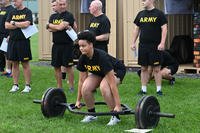Many veterans make the transition out of the military and into the law enforcement profession, but learn that the PT tests will be different and challenge them in a way they were not in the military. If you are more used to running and rucking in boots, the transition to good-fitting running shoes and faster-paced running can cause foot and lower leg pain.
Here is an email from a veteran preparing for a federal law enforcement job who’s developed running pain that he has not experienced before.
Hi Stew, I am a former Army soldier preparing for the FBI. The runs are usually not an issue, but the combination of 300-meter and 1.5-mile runs together are triggering some pain for me. Recently, the top and front of both ankles have been hurting when I run, and they are sore and achy afterward. Any idea what this is and how I could treat it? Thanks, Dave
Dave, Thanks for your service and hopefully for your continued service to this country. There are several issues you may want to consider with your training program, running surfaces, running form and running footwear:
Different events than previous training. After running and rucking in boots over longer distances at a slower pace, adding a sprint to the training week can increase some soreness. You may want to add in a fast run only 1-2 days a week for the first few months of preparation training as your body gets used to running faster each week.
Often people see these aches and pains in the feet, shins, Achilles’ tendons, calves and hamstrings. Your body must get accustomed to the force of accelerating and maintaining speed for 300 meters by building up speed and distance progressions over time. In other words, do not do too much, too soon or too fast when you start training.
Different footwear. If you’re now running in a different pair of shoes, you may need to adjust a few areas that were supported previously by your boots. Depending on the brand, the top lace of a new pair of shoes can be too tight and cause some mild bruising on the top of the foot near the bend in the ankle when you’re sprinting. You may want to tie your shoes differently when you sprint or for timed 1.5-mile runs and goal-pace running. If your shoes are old, maybe you need new ones. Running on older shoes can cause aches in the feet, ankles and shins.
Volume of current running. If it has been awhile since you have been a runner. You may want to start with short distances before you build up to 10-15 miles per week. My advice would be to start with a mile per day of running and progress 10%-15% each week. Mix in more non-impact cardio options to build up your heart and lungs without impact pain. You still can do the speed work and soon will be in the 1.5-mile-a-day range to focus on your timed event. But give yourself a month or two to build to higher volumes even if you thought 20 miles a week was easy a few years ago.
Running surfaces. If you have not run much in the last year, you may want to start running on softer ground. Consider a rubberized high school track, the turf or grass just inside the track, a field, trail or treadmill as you get your body used to the impact. If you start out running on concrete or pavement, you might develop pains from the feet up to the hips and lower back.
Shin splint pain. Some shin splints can start down low on the leg near the point you are feeling the pain. Regardless of the cause, try stretching your ankles. You can do this by sitting on them or trying a thigh stretch where you grab your foot and take your heel to your butt; this also stretches the ankle and thigh. But do not look only at the ankles. Consider the entire foot and include toes, arches, heel and ankles in your mobility and strengthening work. See article/video from StrongFirst that teaches a solid program to help build your feet and ankles.
One final thing: Foot flex during running impact. When you run, see whether you feel yourself flexing your ankles when you run. You could be over-striding and causing a hard heel impact, followed by a foot flex that leads to ankle and shin pain. You should be relaxing your ankles slightly when you run, and that will take pressure off the front of your ankle as well as your shins on impact.
Your issue could have a wide variety of causes and maybe more than one, so go through the list and test out a few new pieces of footwear and methods of running. Make sure you pull back on your volume if you find that you’re going too hard, too soon.
Recommended reading: Favorite Running Workouts, Recurring Shin Splints and Healing Tips
Stew Smith is a former Navy SEAL and fitness author certified as a Strength and Conditioning Specialist (CSCS) with the National Strength and Conditioning Association. Visit his Fitness eBook store if you’re looking to start a workout program to create a healthy lifestyle. Send your fitness questions to stew@stewsmith.com.
Want to Learn More About Military Life?
Whether you're thinking of joining the military, looking for fitness and basic training tips, or keeping up with military life and benefits, Military.com has you covered. Subscribe to Military.com to have military news, updates and resources delivered directly to your inbox.


















